|
AND A COUSIN THE REMINGTON-BEALS AN ARMY AND TWO NAVIES- PART 3
|
|
|
.36 CAL. SINGLE ACTION REVOLVER
|
|
|
As stated in Parts 1 and 2 , Remington, like Colt, was in business
of arms making long prior to the Civil War. They had been producing
handguns since 1857 when they introduced the Remington-Beals Pocket
Revolver. With the outbreak of the Civil War all of the company's
energy became devoted to the military production of long arms and
hand guns. The martial hand guns produced during the Civil War period
included the Remington-Beals Army and Navy Model revolvers,
the Remington Models 1861 Army and Navy Revolvers, (a.k.a. as
the "Old Model Army" and "Old Model Navy") and the Remington New Model
1863 Army and Navy revolvers. Of these 6 models, I have but 3. They
are the Remington-Beals Navy and the New Model 1863 Army and Navy
revolvers. Their pictures and descriptions follow:
|
|

From Top To Bottom Remington
New Model 1863 Single Action .44 Caliber Percussion Army Revolver
(1863-1875)
|
|
|
|
|
|
Approximately 15,000 Remington-Beals Navy Model Revolvers were manufactured
from 1860 to 1862. Serial numbered from 1 on up and overlapping numbers
in the Model 1861 Navy range. Riley states that the U.S. government
purchased 7,350 Beals Navy revolvers between August 17, 1861 and March
31, 1862 which may or may not have included 1,100 which were purchased
on the open market. However, Flayderman provides information
that only the last 1,000 made were sold to the government and they
were martially marked. Based on my own experiences, I have seen very
few of these arms martially marked so either most were not so marked
or the statement as to 7,350 being purchased by the government is
in error. Noting that the production of the Beals' Navy .36
caliber revolver preceded the Beals' Army .44 caliber revolver, it
is possible that some of these were sold to the Southern states as
it is recorded that the State of South Carolina purchased 1,000 of
the Army production in 1860. Army production is estimated by
Riley to have be less than 2,000 while Flayderman states it as 2,000
to 3,000. If the Southern states were purchasing Armys in 1860,
why would they not have also bought some Navies? They were available
before the Army Model and later co-existed with them. Just an opinion,
but I would bet on it. Either way, it's a safe bet that a great many
of the Beals Navy revolvers saw extensive service during the Civil
War, martially marked or not.
|
|
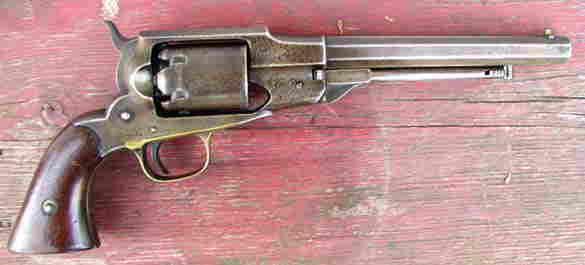
|
|

Right And Left Side Views of The Remington Beals Single Action .36 Caliber Navy Model Revolver
|
|
|
The Remington -Beals .36 caliber Navy arm was the first martial type
revolver produced by Remington. A few hundred thousand Remington
revolvers followed it into the Civil War and after. They were
all outstanding arms for their day and served this country well and
often. Well made and competitively priced they did their job
well. This allowed Remington, like Colt, to make their mark under
fire, and to endure as an arms corporation to this day.
|
|
|
|
|

Left Side View of The Remington-Beals Navy Revolver With Loading Lever Dropped Cylinder Arbor Pin and Cylinder Removed
|
|
|
This single action arm is caliber .36 rifled with 5 grooves. It is
14" overall and weighs 2 pounds, 10 ounces. The blued octagonal
barrel is 7-3/8" long. It is marked, on the top flat, "BEALS' PATENT.
SEPT. 14. 1858 / MANUFACTURED BY REMINGTONS' ILION. N.Y."
in 2 lines. The serial number, "6908" is stamped on the bottom barrel
flat towards the rear. It is only visible when the loading lever is
lowered. The serial number can also be found on the hooked trigger
guard projection which fits into the frame and on the grip frame under
the grips. Sometimes, but not on this gun, the serial number is also
stamped on the back of the cylinder and/or on the inside of the grips
themselves. The front sight is a German silver cone mortised into
the top flat 7/16" from the muzzle. It is .2095" in circumference
and height. Rear sighting is done through the 2-1/4" "V" groove along
the length of the top strap. The loading lever catch, which screws
into the barrel, 1-7/16" back from the muzzle, is a round post 3/8"
long and notched at the rear to hold the spring loaded catch at the
front of the loading lever. The earlier production Beals had a flat
faced lever catch mortised in to the barrel.
|
|

BARREL
ADDRESS
|
|
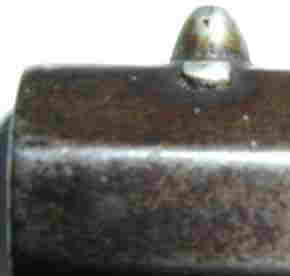
GERMAN SILVER CONE FRONT SIGHT
|

SERIAL
NUMBER STAMPING ON BOTTOM BARREL FLAT
|
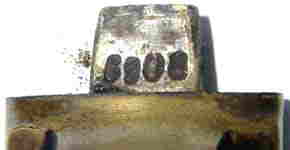
SERIAL
NUMBER STAMPING ON TRIGGER GUARD HOOK
|

SERIAL
NUMBER STAMPING ON GRIP FRAME
|
|
|
|
|
The blued, one piece solid frame is unmarked. There is no other stamping
on this arm other than the barrel address and the serial numbers as
pictured. The frame covers the barrel threads. The front of the frame
is inlet to receive the wings or finger lugs of the 4" long
cylinder arbor. The grip straps are blued. The oval brass trigger
guard is not plated. The two-piece, oil-finished black walnut wood
grips are unmarked. The hammer is (or was) case-hardened in mottled
colors. It should be noted that the cylinder arbor on this model under
went several variations. The very early models were fitted out with
a single-wing arbor containing a machined slot that held a small 1-1/2"
long rod. It was thought to be a nipple pick or it was used
to tear the back of a paper cartridge. After that the double wing
arbor was utilized, but some of them had the machined slot included
in the loading lever and the cylinder arbor could not be completely
withdrawn. Those features gradually disappeared and production became
more or less standard.
|
|

BOTTOM VIEW OF CYLINDER ARBOR PIN
|

TOP VIEW OF CYLINDER ARBOR PIN
|
|
The cylinder pin arbor can only be withdrawn when the 4-1/8'' (from
arbor notch to end catch) loading lever is lowered. In normal
position, the loading lever prevents the accidental withdrawal of
the cylinder arbor. The arbor on this arm can be withdrawn it it's
entirety when the loading lever is lowered. The knurled tapered lever
latch is distinctive to this arm as is the much smaller loading lever
web.
|
|
|
|
|
|
The six-shot unmarked blued cylinder is 2" long overall. There are
no intermediate safety rests between the nipple recesses. The stop
slots are rectangular in shape. The cylinder diameter is 1-1/2" (1.4920
caliber reading).
|
|
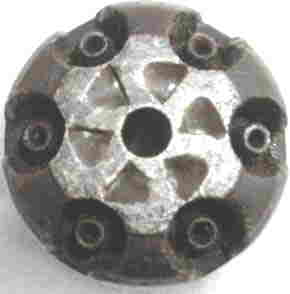
BACK OF CYLINDER
|
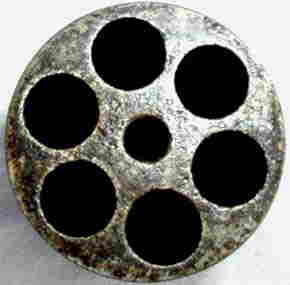
FRONT OF CYLINDER
|
|
|
|
| One
last look at all three models...
|
|

From Top To Bottom Remington
New Model 1863 Single Action .44 Caliber Percussion Army Revolver
(1863-1875)
|
|
|
|
|
|
Reference material and wording credits go to Robert M. Reilly
and his book "U.S. SMALL ARMS 1816 - 1865", Norm Flayderman's FLAYDERMAN'S
GUIDE TO ANTIQUE AMERICAN FIREARMS... AND THEIR VALUES", and William
B. Edwards' CIVIL WAR GUNS.
|
|
|
Reed Radcliffe, my son and webmaster, maintains this web site.
Without his expertise it would not be here.
|
|
| Dave
Radcliffe
|
|